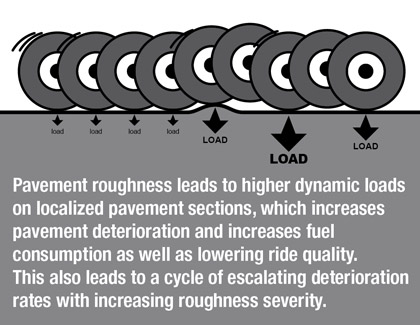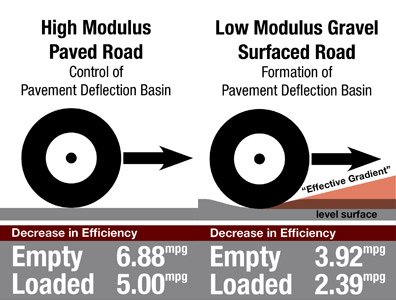Saving Energy & Costs Green Technology Road Improvements
After the long gas station lines of the two OPEC (Organization of Petroleum Exporting Countries) crises of the 1970s, the onus for reducing fuel consumption was placed squarely on the consumer by mandatory programs, such as the maximum 55 mph highway speed limit, high occupancy vehicle (HOV) lanes and incentivized car pooling. This burden to reduce fuel was expanded in the 1980s to include automotive/truck trade and suppliers with dictated mileage goals. While both consumers and businesses have had periods of lessening and increasing fuel burning during the past 30 years, the road and highway infrastructure in nearly every state within the U.S. has deteriorated. The responsibility and ambition to decrease energy use by all parties have not abated.
Road systems may be one of the largest, most immediate and least expensive sources of untapped energy savings available. Improved roads can provide significant reductions in fuel consumption at no additional cost to road users and with no changes required as far as driving habits or type of vehicle used. At the same time, road owners can construct more fuel-efficient pavement systems and stabilized running surfaces at lower cost than conventionally designed roads through innovative, sustainable product technology.
Fuel Consumption & Pavement Condition Link
1. Surface Texture and Roughness
Studies on environmental impacts and road pavement fuel efficiency have found that total energy consumption related to construction, maintenance and road operation will be dominated by the fuel expended by road users. Three primary properties of paved and unpaved roads effect fuel economy: surface texture, roughness (smoothness) and stiffness (resistance to deflection). Road surface texture and ride roughness effect rolling resistance. Vibration inputs in the tires and suspension system, and deformation of tires and shock absorbers cause energy losses and added rolling resistance. This increases fuel consumption of cars and trucks operating on roads not smooth in surface texture and running surface alignment. According to a 2011 National Center for Asphalt Technology Report, Synthesis of the Effects of Pavement Properties on Tire Rolling Resistance, “Improvements in pavement roughness could directly improve fuel efficiency by approximately 2 to 6 percent.”
2. Stiffness
Pavements deform to varying degrees and are subject to stresses and strains from cars and trucks. The more a pavement deforms under loading, the more energy is required to keep a car or truck moving at a constant velocity. Assuming similar quality of roughness and surface texture, a pavement that remains stiff and resistant to deformation will be more fuel efficient compared to a pavement that deforms under loading.
According to Leif G. Wathne, P.E. and vice president-highways and federal affairs with the American Concrete Pavement Association, “Arguably, the most statistically rigorous . . . comprehensive, multi-phase study on the effects of pavement structure on vehicle fuel consumption was published in 2006 by the National Research Council Canada. The study concluded that tractor-trailers traveling on rigid pavements consume significantly less (on average about 3.8 percent) fuel than those traveling on flexible pavements.” As is evident, the most fuel efficient road will have a smooth surface texture and smooth running surface alignment as well as the ability to retain stiffness (high modulus) and resist deformation.
Fuel Consumption & Road Surface Link
According to the Federal Highway Administration (FHWA), approximately 1.5 million of the more than four million miles of public roads and streets in the U.S. are unpaved. This does not include military facility roads or industrial roads on private property. Military supply roads, often known as “MSR’s,” or “Tank Trails,” are a good example of unpaved roads that frequently support heavy traffic volumes and heavier loads than allowed on paved public roads. The relative surface texture, roughness and all-weather stiffness of these unpaved MSR’s affect the travel speed and ride quality. They also increase the required maintenance frequency for the vehicles, trucks and tactical military equipment using the roads. At large military bases with busy practice ranges in service for sizable fleets of tactical military equipment, the three primary properties effecting fuel consumption rates on paved roads are also greatly impacting fuel consumption rates on gravel and aggregate surfaced roads.
When approximately 75 percent of the energy consumption at such a military base is related to fuel demands of tactical military equipment fleets, the smoothness of the running surface and the all-weather stiffness of these roads will obviously have a major impact on the energy use of the entire base. This tactical military equipment includes M1A2 Abrams Tanks, Bradley Infantry Fighting Vehicles and loaded M-1070 Transporter units weighing almost 240,000 pounds – all moving in convoys throughout hundreds of miles of unpaved roads. Energy efficient buildings and renewable energy generation provide multiple benefits. But, when approximately 75 percent of an installation’s energy usage is consumed by its tactical fleet operations, construction of more energy efficient roads may be a strategic, untapped and cost-effective driver for even greater energy savings. This could be a particularly important option given that more than 80 percent of the military’s hundreds of thousands of roads are unpaved.
A study published in the Transportation Research Record, Engineering and Legislative Options for Improved Timber Haulage in Scottish Forests, which included research on fuel consumption of logging trucks operating on gravel surfaced logging roads, is highly informative and analogous to this topic. With truck preparation and calibration of its on-board computers under direction of the truck manufacturer, the study found that fuel consumption of both loaded and empty logging trucks was increased by a factor of approximately two times when operated on gravel roads instead of paved roads. While not directly related to the subject of fuel consumption, the study also concluded that trucks predominantly operating on gravel roads needed replacement on 3-year cycles, versus a 7-year cycle for trucks operating primarily on paved roads.
In addition, Transportation Research Board Special Report 286, Tires and Passenger Vehicle Fuel Economy, published by the National Research Council, states: “The roadway can also contribute to rolling resistance by deflecting or deforming under the weight of the wheel load. How much energy is lost will depend on the rigidity of the roadbed and overlay. Dirt and gravel roads deform the most and give rise to twice as much rolling resistance as harder paved surfaces (DeRaad 1978).” With hundreds of thousands of miles of aggregate and gravel surfaced roads in the United States, and millions of kilometers of similar roads throughout the world, one may safely conclude that upgrading these roads to a level of smoothness and stiffness more similar to paved roads could provide a tremendous reduction in energy consumption, related carbon emissions and general air pollution.
Innovative Product Technology Increases Fuel Efficiency
Three requirements are universal for any fuel efficient road – paved or unpaved. A fuel efficient road must first provide sufficient strength and stiffness to support the heaviest anticipated design loads and loading frequencies through all-weather conditions. Second, in order to provide a consistently high level of all-weather service, the road structural section design must adequately address potential problems generated by normal fluctuations in moisture content and humidity in the road environment, and frost susceptibility problems in cold climates. Third, road design must successfully anticipate potential problems within the pavement structural section and in the native sub-grade or embankment below, which generate differential settlement and loss of pavement smoothness.
For a wide variety of paved and unpaved road construction projects, a sustainable solution is available that has been proven effective in providing strength and stiffness, and treatment of moisture and frost susceptibility problems required for paved roads and highway and aggregate surfaced roads to retain fuel efficient characteristics over extended periods of years. In field service since 1988, the EMC SQUARED System stabilization products have been successfully utilized to stabilize dirt, gravel and aggregate surfaced roads from cold climate locations, such as the Haul Road in northern Alaska, which accesses the Prudhoe Bay oil fields, to tropical service conditions in Brazil and other South American countries. The stabilized aggregate running surface constructed as a Federal Highway Administration (FHWA) Experimental Feature Project by the State of Alaska1 was reported by the Haul Road truckers to be far smoother running than the newly paved asphalt road to which it was attached. A U.S. Forest Service logging road2 winding through the steep mountainous terrain of the Ozarks in Arkansas remains stable and smooth-running 22-years after being upgraded with a stabilized aggregate running surface.
The EMC SQUARED System has also proven effective in protecting and extending the smooth running service life of interstate freeways, highways, roads and streets in the continental United States.
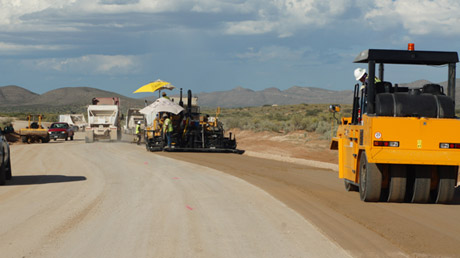
© SSPCo
For example, the section of the Dallas-Fort Worth Turnpike (Interstate 30) constructed on top of a sub-grade stabilized with an EMC SQUARED System treatment is described by the Dallas District of the Texas Department of Transportation3 as “the smoothest running section” of Interstate 30 in the Dallas District. In New Mexico, one of the most problematic sections of the Interstate 40 freeway in the state,4 a section that previously required complete, full-depth reconstruction on a three- to five-year frequency, has been smooth-running and free of repair requirements for 12-years since being constructed on top of a sub-grade stabilized with the EMC SQUARED System.
The I-40, New Mexico project has been continuously monitored since construction by FWHA Area Engineer Ray Pederson. He reviewed the results of the latest smoothness tests taken by the state in 2011, which were subsequent to the applications of an open-graded friction course – a standard safety maintenance procedure to reduce water spray off tires and to improve friction of the asphalt pavement surface. According to Pederson, the results show that this section is as smooth-running as it was at the time of its initial construction. He reports that it is also significantly smoother than adjacent sections with subgrades treated with lime, reinforced with geosynthetic products or constructed without any conventional chemical or mechanical stabilization measures.
Common to all these applications is improvement of strength characteristics, or modulus of treated materials, in combination with improved resistance to water saturation, fluctuations in moisture content and freeze-thaw phenomenon. Moisture barrier aspects contribute to a more stable state of moisture content in the native soils below the stabilized layer. These can be a stabilized aggregate running surface, a stabilized aggregate base course or a stabilized soil sub-grade and, therefore, contribute to improved stability of native soils underlying road alignment. The benefit of retaining a state of moisture equilibrium in the stabilized layer and native soils below is the retention of the smooth running surface alignment of the road as originally constructed. Counteracting environmental conditions that generate differential settlement under the road alignment and roughness in the running surface is the ultimate goal for all road stabilization measures.
The benefits of these EMC SQUARED System applications are being delivered by non-toxic concentrated liquid products that effectively stabilize a wide variety of virgin aggregate and native soil materials, as well as recycled pavement materials, such as produced by full-depth reclamation (FDR) road improvement projects. The breadth of materials that can be effectively treated is unique to this stabilization product technology. Cost savings are realized in comparison to use of geosynthetic reinforcement products and asphalt emulsion, cement and lime-based stabilization treatments. As illustrated in the case study that follows, even bigger savings are realized on projects where requirements for imported crushed aggregate materials can be eliminated by effective soil stabilization treatment.
USACE: Demonstrating Low Cost & Increased Performance
As earlier addressed, research studies have found that trucks operating on unstabilized gravel surfaced roads consume approximately twice the fuel as trucks operating over a similar length of paved road. The rough surface texture and rough running surface alignment of the unstabilized gravel surfacing add significant rolling resistance. The deflection basins generated in the low modulus gravel surfacing under heavy wheel loads create an effective gradient that essentially has the truck in a state of continually running up a grade, even when operating on a level grade alignment.
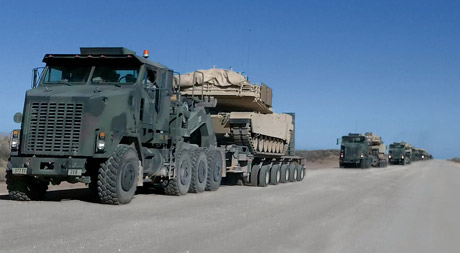
© SSPCo
A low cost stabilization technology retaining a smooth running surface in all-weather conditions that provides equal or better stiffness than asphalt pavement under heavy loads would obviously have a major impact. Even better would be to save money on road construction and maintenance as a result of stabilizing the gravel or aggregate surfacing.
Stretching into Texas and New Mexico, Fort Bliss is the Army’s second largest Maneuver Area for heavy armor training activities. The U.S. Army Corps of Engineers (USACE) provided the design for a series of eight MSR’s at Fort Bliss totaling more than 100 miles in length.5 And, they included an option to treat locally available native soils with an EMC SQUARED System application as an alternative to manufacturing and hauling the more than one million tons of crushed sub-base aggregate that would otherwise be required by conventional heavy haul road design. Even though 22 distinct soil types were reportedly encountered, in-place soil stabilization produced an estimated savings of $20 million, which allowed more miles of MSR to be constructed with the available budget. All eight MSR’s were constructed with stabilized soil sub-grades and then surfaced with 8-inches of stabilized aggregate surface course material at 40-ft. widths. Asphalt paving machines were used to place the stabilized surfacing with smoothness similar to the nearby paved state highway for almost 80 miles of MSR construction.
Testing of the stabilized aggregate material used to surface these roads was conduced under the direction of Peter Sebaaly, Ph.D. and director of the Western Regional Superpave Center (WRSC) at the University of Nevada, Reno Campus, a facility used by FHWA for asphalt pavement materials evaluation.6 The Dynamic Modulus and Repeated Load Triaxial laboratory study determined that stabilized aggregate performed as an elastic pavement material, behaving as a flexible pavement layer with a nearly consistent level of strength and resistance to permanent deformation through all temperatures and loading conditions in contrast to hot mix asphalt materials, which are viscoelastic in nature and weakened by increasing temperatures and slow loading conditions.
The results show that stabilized aggregate materials have resistance to permanent deformation superior to typical hot mix asphalt materials, and that stabilized aggregate was stronger in Dynamic Modulus testing under worst-case conditions for pavement materials – warmer temperatures and slow-moving heavy loads. The Report recommended use of these stabilized aggregate materials for pavement installations designed to be loaded under such severe conditions. As evident from the laboratory study results, the field performance of stabilized aggregate materials and the broad spectrum of native soils stabilized during construction of Fort Bliss roads, the stabilization product technology is providing a range of performance capabilities and cost-efficiencies not demonstrated by conventional asphalt, cement and lime-based products.
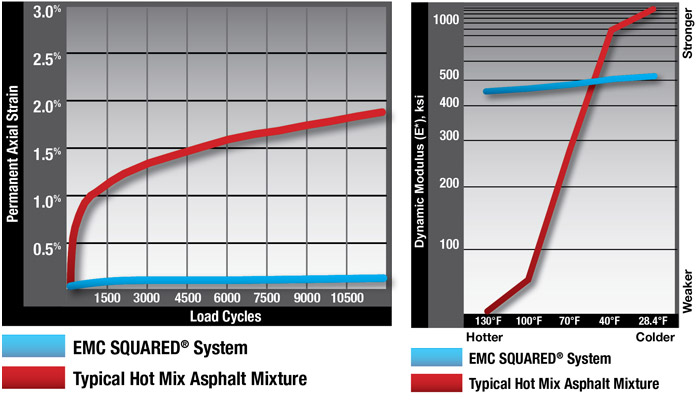
© SSPCo|Left: Permanent deformation curves for Typical Hot Mix Asphalt mixture and an EMC SQUARED® stabilized aggregate mixture. Right: Typical Dynamic Modulus Data for Hot Mix Asphalt mixture and EMC SQUARED® stabilized aggregate mixture.
Summary
Smoother, stronger roads reduce fuel consumption. Improvements to roads offer greater energy efficiencies and increased options to reduce costs than generally realized. The timely arrival of innovative stabilization technology provides new opportunities to significantly reduce energy use and climate change effects while simultaneously creating road improvements not otherwise realized through traditional road products and applications.










